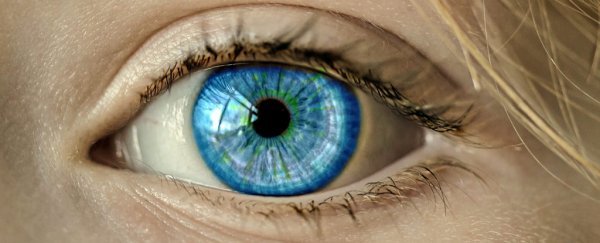Your eyes aren't blue (or green) because they contain pigmented cells.
As Paul Van Slembrouck writes for Medium, their colour is actually structural - and it involves some pretty interesting physics.
The coloured part of your eye is called the iris, and it's made up of two layers - the epithelium at the back and the stroma at the front.
The epithelium is only two cells thick and contains black-brown pigments - the dark specks that some people have in their eye is, in fact, the epithelium peeking through.
The stroma, in contrast, is made up of colourless collagen fibres. Sometimes the stroma contains a dark pigment called melanin, and sometimes it contains excess collagen deposits.
And, fascinatingly, it's these two factors that control your eye colour.
Brown eyes, for example, contain a high concentration of melanin in their stroma, which absorbs most of the light entering the eye regardless of collagen deposits, giving them their dark colour.
Green eyes don't have much melanin in them, but they also have no collagen deposits.
This means that while some of the light entering them is absorbed by the pigment, the particles in the stroma also scatter light as a result of something called the Tyndall effect, which creates a blue hue (it's similar to Rayleigh scattering which makes the sky look blue).
Combined with the brown melanin, this results in the eyes appearing green.
Blue eyes are potentially the most fascinating, as their colour is entirely structural.
People with blue eyes have a completely colourless stroma with no pigment at all, and it also contains no excess collagen deposits.
This means that all the light that enters it is scattered back into the atmosphere and as a result of the Tyndall effect, creates a blue hue.
Interestingly, this means that blue eyes don't actually have a set colour - it all depends on the amount of light available when you look at them.
Structural colouration also gives colour to butterflies, beef and berries.
It's pretty mind-blowing stuff.
Van Slembrouck writes for Medium:
"Imagine that you could shrink yourself to a microscopic size and then climb through the mesh of fibres in the stroma. That's where structural colouration is coming from…
… and in the mesh are also strands of smooth muscle tissue that contract to dilate (expand) the pupil, pulling the inner edge of the iris toward the outer edge. When this happens, the stroma fibres slacken and may become wiggly as tension is released. This makes me wonder, does that slightly alter the colour of your eye as well?"
Check out Van Slembrouck's great story to find out how hazel and grey eyes get their colour, and also to check out his beautiful diagrams that explain structural colouring.
Source: Medium
